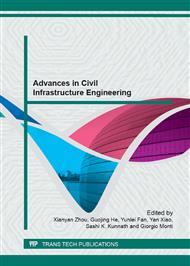p.544
p.548
p.554
p.567
p.573
p.577
p.581
p.587
p.593
Study on Identification and Classification of Expansive Soil Based on Bayes Discriminant Analysis Method
Abstract:
Based on the principle of Bayes discriminant analysis, Bayes discriminant model (BDM) for evaluation of expansive soil in sub-grades is established. Four indexes including free expansive ratio, liquid limit, plasticity index and moisture content of standard absorption are selected as the factors for synthetic evaluation of expansive soil. The grade of shrink and expansion is divided into four grades that are regarded as four normal populations in Bayes discriminant analysis. Bayes discriminant functions obtained through training a set of expansive soil samples are employed to compute the Bayes function values of the evaluating samples, and the maximal function value is used to judge which population the evaluating sample belongs to. The optimality of the proposed model is verified by back-substitution method. The study shows that the prediction accuracy of the proposed model is 100% and could be used in practical engineering.
Info:
Periodical:
Pages:
573-576
Citation:
Online since:
January 2013
Authors:
Price:
Сopyright:
© 2013 Trans Tech Publications Ltd. All Rights Reserved
Share:
Citation:


